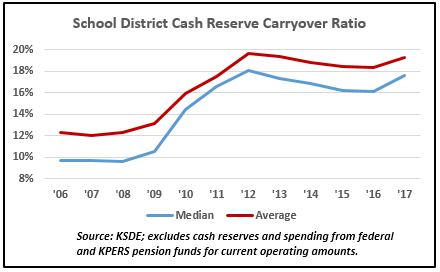State legislators are legally required to keep cash reserves equal to 7.5 percent of General Fund spending but the average Kansas school district had nearly three times that level – 19.3 percent – in reserve at the beginning of the 2017 school year. That disparity should prompt considerable discussion in the upcoming legislative session. A state efficiency study recommended capping school cash reserves at 15 percent and doing so would produce one-time savings of about $255 million based on this new data, but legislators have been unwilling to seriously consider the matter in prior years.
Kansas Department of Education (KSDE) data used to calculate the carryover reserve ratio excludes spending and reserves related to current spending from federal and KPERS pension funds as well as capital outlay and debt payments. Many school districts demonstrate strong cash management skills by consistently operating with less than 10 percent held in reserve while many others choose to keep more than 20 percent on hand. Each district’s cash carryover ratio can be found here at KansasOpenGov.org and their individual fund balances can be found here.

School district reserve levels have long been higher than required for the state budget; the average carryover ratio was 12.3 percent when it was first tracked for the 2006 school year but it jumped significantly beginning with the 2010 school year. Media reports say KSDE advised districts to build cash reserves when the Legislature was late making payments during the recession, but payments have consistently been on time for many years now.





